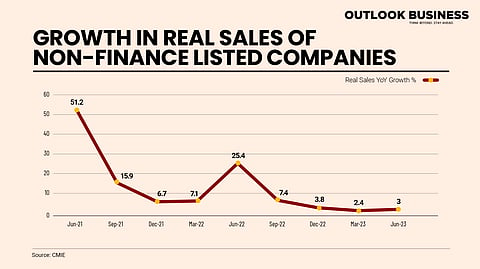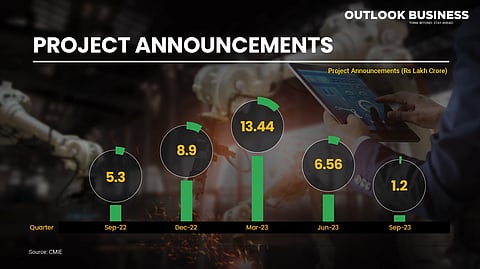When Finance Minister Nirmala Sitharaman announced a substantial increase in government’s capital expenditure with the expectation of crowding in private investment, hopes were high that the year 2023 is going to see strong corporate investments. The finance minister proudly asserted, “This substantial increase in recent years is central to the government’s efforts to enhance growth potential and job creation, crowd in private investments, and provide a cushion against global headwinds.”
Centre's Fiscal Constraints, Private Sector's Missing Capex May Hurt India's Growth
Government has been lifting the capital expenditure in 2023. But with fiscal consolidation target in mind of policymakers, experts say that the private sector will soon need to lead the way
While the government has fulfilled its promise of going big on capex in the first six months of FY24, data suggests that it has not been able to revive the ‘animal spirits’ of the private sector. In Q1FY24, the government used close to 28 per cent of budgeted expenditure. As per a senior official quoted by Moneycontrol, the government was on track to utilise 60 per cent of the budgeted expenditure by the end of September 30.
Corporate tax cuts, production linked incentive scheme and the front of loading of capex, Modi government has used several tricks up its sleeve to push India Inc to contribute to the India growth story. But so far, the stubborn sluggishness of the corporate sector seems to be continuing.
A new Goldman Sachs report this week cautioned that the pace of investments by the government can’t remain the same. The government has a medium-term goal of fiscal consolidation, with the plan of cutting fiscal deficit by 1.5 per cent of GDP in the next two years. As expectations of government's move towards cutting down capex increase, will this be the moment for India Inc to rise to the occasion and lead the way?
Slowing Down
In an economic research report, analysts at Goldman Sachs pointed out that the rate of increase in capex seen in the last few years is not sustainable going forward, given the fiscal consolidation goal. “With subsidies already near the pre-pandemic lows, it is likely that a cut in public capex (as a % of GDP) will have to share the burden of fiscal consolidation, among a reduction in other current expenditure, and likely some improvement in tax receipts,” they noted.

The public capex has risen at the CAGR of 33 per cent in the last three years to reach 3.3 per cent of GDP. Between FY18 and 20, public capex constituted 1.4 per cent of GDP. The accommodation for increased capex funding has been done by cutting down the share of subsidies in GDP. As per the data compiled by Goldman Sachs, the government’s subsidy went down from 4 per cent of GDP in FY21 to 1.4 per cent in FY24. Due to the food and oil supply shocks, subsidy’s share is expected to increase by 0.3 per cent.
The government has received some respite from increasing tax collections. As per the data released till October 9 for direct tax collections, the amount is up by almost 18 per cent. The growth is driven by personal income tax, with net growth at 32.51 per cent, while corporate tax collection has risen by 12.39 per cent.
However, analysts expect the fiscal consolidation plan to have a bearing on government’s public capex outlay going forward. Paras Jasrai, Senior Analyst - Public Finance, India Ratings & Research, says, “The government has not much leeway available to continue with the capex momentum, like past couple of years, going forward.”
As per research done by Motilal Oswal Financial Services Limited (MOFSL), the first six months of 2023 saw households and government holding the forte in terms of investment. The data showed that in Q4FY23 and Q1FY24, total government (states + centre) investment grew by 18.5 and 54.1 per cent respectively. For households, the numbers stood at 19 and 12.9 per cent.
With government capex moment slowing down and household savings reaching a 34 year low at 5.1 per cent of GDP, all eyes are now on the corporate sector. Goldman Sachs noted, “To offset [slowdown in government capex], the Indian private corporate sector has an opportunity to increase investment growth over this decade.” Jasrai says that sooner or later, the private sector has to take the lead.
But will they? The numbers don’t give too much hope at the moment.
Pressure Of Stepping Up
At the time when government and households were driving investment in the economy, corporate investments disappointed. As per MOFSL estimates, corporate investment declined by 0.5 per cent and 6.2 per cent in Q4FY23 and Q1FY24 respectively.

Not only 2023, but the numbers also align with the trend of sluggish investments by India Inc. An analysis of balance sheets of 3,420 companies by Bank of Baroda economist Dipanwita Mazumdar reflected the problem. As per her calculation, fixed asset creation of corporates grew at CAGR of 4.9 per cent, lower than 9.8 per cent CAGR in nominal GDP.
The cautiousness of the private sector has been attributed to several reasons. Experts cite the worsening global economic environment and slump in demand in the country. Even in a quarter where the Indian economy grew by 7.8 per cent, the numbers suggest that private sector continued to be cautious.
While the profit margins of the corporate sector have seen improvement, recent CMIE data suggests that there is pressure on the topline. According to its calculations, the net sales of non-financial listed companies saw a drop below the average real sales growth since 2007. It shows that the average real sales growth is around 7.5 per cent since 2007 but the real sales saw a growth of 3 per cent in June quarter.

Amidst a sluggish corporate investment environment, the inflow of FDI has also been a matter of concern. World Bank’s recent India Development Update suggested that FDI inflow in the country has been lower than the pre-pandemic level for last four consecutive quarters.
Gaura Sengupta, Economist at IDFC First Bank, says, “The slowdown in FDI flows is a global phenomenon with UNCTAD data showing a decline in 2022. The slowdown likely reflects volatile global environment especially in 2022 with rise in inflation pressure and central banks embarking on tightening financial conditions.”
UNCTAD data shows that FDI declined globally by 12 per cent last year. The recent IMF projections of growth rate don’t give too much hope on the FDI front. United States is expected to slowdown from 2.1 per cent GDP growth in 2023 to 1.5 per cent while China will see a decline in growth from 5 per cent to 4.2 per cent in 2024.
With FDI not being the bankable option and private sector still not opening up purse strings significantly, the government finds itself in a tough spot. As corporate earnings start trickling in over the month of October, eyes will be on whether the September quarter saw some uptick in investments by private players.
Project announcement data recently released by CMIE showed that investment environment has largely been subdued. As per the data, 390 projects worth Rs 1.22 lakh crore were announced in the September quarter, which was significantly lower than the same period in previous year when 797 projects worth 5.25 lakh crore were announced.

Analysts are of the opinion that private players are in a wait and watch mode ahead of 2024 elections. MOFSL note said, “The lagging corporate capex may continue until the general elections next year.”
Amidst a tough global macroeconomic environment and sluggish domestic private investment, the government is stuck between a rock and a hard place. With inclusion in global bond indices, India’s public accounts are set to face more scrutiny which means that the finance ministry will try to stick to the fiscal deficit target over the next two years and bring it below 4.5 per cent of GDP.
The government would need the private sector to start pulling their weight and crowd in with their investments. Will India Inc step up? Only time will tell.